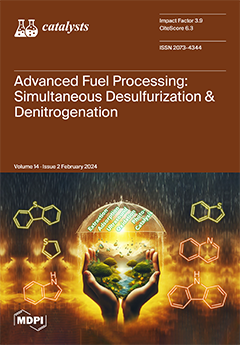The La
2O
3 catalyst exhibits good performance in OCM reactions for its promising C
2 selectivity and yield. Previous studies have affirmed that the formation of carbonates in La
2O
3 impedes the catalyst’s activity as a result of poisoning
[...] Read more.
The La
2O
3 catalyst exhibits good performance in OCM reactions for its promising C
2 selectivity and yield. Previous studies have affirmed that the formation of carbonates in La
2O
3 impedes the catalyst’s activity as a result of poisoning from CO
2 exposure. In this study, a series of Na
2WO
4-impregnated La
2O
3 catalysts were synthesized to investigate the poisoning-resistant effect. The bulk phase and kinetics of the catalysts were analyzed in reactors employed with in situ XRD-MS and online MS, focusing on the CO
2 adsorption on La
2O
3 and the phase transition process to La
2O
2CO
3 in temperature zone correlated to OCM light-off. In situ XRD analysis revealed that, with Na
2WO
4 doped, CO
2 exposure at elevated temperatures formed La
2O
2CO
3 in tetragonal crystal phases, exhibiting distinctive differences from the hexagonal phase carbonates in undoped commercial La
2O
3. The ability to develop tetragonal or monoclinic La
2O
2CO
3 was suggested as a descriptor to assess the sensitivity of La
2O
3 catalysts to CO
2 adsorption, a tunable characteristic found in this study through varying Na
2WO
4 doping levels. Coupled XRD-MS analysis of CO
2 adsorption uptake and phase change further confirmed a positive dependence between the resistivity of La
2O
3 catalyst to CO
2 adsorption and its low-temperature C
2 selectivity. The results extended the previous CO
2 poisoning effect from multiple perspectives, offering a novel modification approach for enhancing the low-temperature performance of La
2O
3 catalysts in OCM.
Full article





